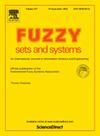模糊β−覆盖下的商逼近空间
IF 2.7
1区 数学
Q2 COMPUTER SCIENCE, THEORY & METHODS
引用次数: 0
摘要
商空间是将细粒度空间转化为粗粒度空间过程中的主要研究对象。然而,为了获得更好的应用效果,我们相对缺乏有效的粗糙算子模型来实现原始空间与其商空间之间的正则逼近变换。针对这种情况,我们将尝试采用一种全新的方法,在原始空间及其商空间上定义新颖有效的模糊β覆盖粗糙集算子模型,从而建立更好的变换关系和相关应用。首先,我们用自然商映射定义了一个诱导模糊商映射。这使得自然映射下的清晰子集的一系列概念和相关结论可以推广到诱导模糊商映射下的模糊子集。然后定义了商模糊β覆盖近似空间,建立了新的模糊β覆盖粗糙集算子模型。我们不仅研究了它们有趣的变换性质,还将新模型与现有模型进行了比较。此外,还提供了大量的例子来解释每个新概念,并演示了主要结果的简单应用。更重要的是,揭示的深刻的拓扑本质和意义在于,在诱导模糊商映射下,下近似和上近似的变换与拓扑连续映射下的内、闭包变换表现出完全相同的行为。最后,总结了本文存在的不足,并对未来的研究进行了展望。本文章由计算机程序翻译,如有差异,请以英文原文为准。
Quotient approximation spaces under fuzzy β−coverings
The quotient space is the main research object in the process of transforming a fine-grained space into a coarse-grained space. However, in order to achieve better application results, we are relatively lacking in effective rough operator models to realize the regular approximation transformations between the original space and its quotient space. In response to this situation, we will attempt to adopt a completely new approach to define novel and effective fuzzy β-covering rough set operator models on the original space and its quotient space, thereby establishing a better transformation relationships and related applications. Firstly, we define an induced fuzzy quotient mapping by the natural quotient mapping. This allowed the series of concepts and related conclusions of crisp subsets under the natural mapping to be extended to the fuzzy subsets under the induced fuzzy quotient mapping. Then the quotient fuzzy β-covering approximation space is defined, and novel fuzzy β-covering rough set operator models are built. We not only study their interesting transformation properties, but also compare the new models with the existing ones. Furthermore, a wealth of examples are provided to explain each new concept and demonstrate the simple applications of the main results. More importantly, the profound topological essence and significance revealed lies in that, under the induced fuzzy quotient mapping, the transformations of the lower approximation and the upper approximation exhibit exactly the same behavior as the transformations of the interior and closure under a topological continuous mapping. Finally, the shortcomings of this paper are summarized and the prospects for future research are presented.
求助全文
通过发布文献求助,成功后即可免费获取论文全文。
去求助
来源期刊

Fuzzy Sets and Systems
数学-计算机:理论方法
CiteScore
6.50
自引率
17.90%
发文量
321
审稿时长
6.1 months
期刊介绍:
Since its launching in 1978, the journal Fuzzy Sets and Systems has been devoted to the international advancement of the theory and application of fuzzy sets and systems. The theory of fuzzy sets now encompasses a well organized corpus of basic notions including (and not restricted to) aggregation operations, a generalized theory of relations, specific measures of information content, a calculus of fuzzy numbers. Fuzzy sets are also the cornerstone of a non-additive uncertainty theory, namely possibility theory, and of a versatile tool for both linguistic and numerical modeling: fuzzy rule-based systems. Numerous works now combine fuzzy concepts with other scientific disciplines as well as modern technologies.
In mathematics fuzzy sets have triggered new research topics in connection with category theory, topology, algebra, analysis. Fuzzy sets are also part of a recent trend in the study of generalized measures and integrals, and are combined with statistical methods. Furthermore, fuzzy sets have strong logical underpinnings in the tradition of many-valued logics.
 求助内容:
求助内容: 应助结果提醒方式:
应助结果提醒方式:


